Sterile Insect Technique Programme against Mediterranean Fruit Fly in the Valencian Community (Spain)
- PMID: 34066344
- PMCID: PMC8148114
- DOI: 10.3390/insects12050415
Sterile Insect Technique Programme against Mediterranean Fruit Fly in the Valencian Community (Spain)
Abstract
The Mediterranean fruit fly, Ceratitis capitata (Wied.), is an endemic pest in fruit-growing areas of the Spanish Mediterranean coast. In the Valencian Community, it represents a serious problem in the cultivation of citrus and numerous species of fruit, such as peach, cherry, apricot, persimmon, etc. For over 50 years, the Department of Agriculture of Valencia has led, promoted, and carried out a C. capitata control programme to protect crops, especially citrus fruits, because this community is the largest national producer and the leading region for fresh citrus exports in the world. Traditionally, pest control has been based on the use of insecticides. However, a reduction of more than 90% of a target wild population was achieved in the frame of a pilot integrated pest management (IPM) project based on the sterile insect technique (SIT), which was implemented from 2003 to 2006. Based on this successful result, in 2007 the Department of Agriculture of Valencia initiated an area-wide integrated pest management (AW-IPM) programme for the suppression of C. capitata, using the SIT as the primary control method. Complementary activities are implemented periodically in hotspots and during different time periods depending on the pest population dynamics. As a result, there has been a reduction of more than 90% in the use of insecticides by aerial means to control C. capitata, as well as a growth trend in exports of citrus and fresh fruits from the Valencian Community in recent years. This paper provides a historical review of the Valencian programme and briefly describes how technological innovations and decision-making tools have contributed to programme efficiency.
Keywords: Ceratitis capitata; autocidal control; fly emergence and release facility; integrated pest management; irradiation; mass-rearing.
Conflict of interest statement
The authors declare no conflict of interest.
Figures





References
-
- Sabater-Muñoz B., Tormos J., de Pedro L., Harbi A., Tur C., Briasco M., Verdú Gallardo M., Beitia F. Estrategias de Control Integrado de Ceratitis capitata en Cítricos. Vida Rural. 2012;353:42–45.
-
- Liquido N.J., Cunningham R.T., Nakagawa S. Host plants of Mediterranean fruit fly (Diptera: Tephritidae) on the island of Hawaii (1949–1985 Survey) J. Econ. Entomol. 1990;83:1863–1878. doi: 10.1093/jee/83.5.1863. - DOI
-
- Tormos J., Beitia F., Asís J.D., de Pedro L. Intraguild interactions between two biological control agents in citrus fruit: Implications for biological control of medfly. Ann. App. Biol. 2018;172:321–331. doi: 10.1111/aab.12422. - DOI
-
- Castañera P. Control integrado de la mosca mediterránea de la fruta, Ceratitis capitata (Wiedemann) (Diptera: Tephritidae) en cítricos. Phytoma España. 2003;153:131–133.
Publication types
LinkOut - more resources
Full Text Sources
Research Materials

